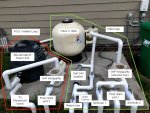Pool noob in search of the invisible water (something I read and got a kick out of).
Bought a home and both pool pump motors need replacing (corroded, locked up). I have two seperate circuits. One for the in-floor cleaning system (Paramount PV3) and heater (Sta-rite Max E-therm). The other for the filtering system including two skimmers and a main drain. I am focused on the filtering system now. Many considerations with the setup of the pool.
Specifics:
-21,000 gallon gunite pool
-2 skimmer lines and one drain line
-2 inch plumbing everywhere
-Pool pump is 96 piped feet away average between the three suction ports (93,93,103) (when you add the east-west run to the north-south run)
-Skimmers struggle but some of that is due to the weir which I am addressing.
-Filter is a Triton II 100C (rec GPM 74, max gpm 98)
-Pentair IC40 Salt cell pool (minimum 20 gpm, max 80 gpm for the cell)
No flow meter....
A few questions:
1) With the potentially high TDH, should I oversize the variable speed pump I choose to deal with the potentially low flow I find when I do install a flow meter? Not a huge price jump from 1.65, 2HP, to 3HP ($100 to $300)
2) Should I get a pump with Viton/ silicon carbide seals (Hayward VS900, VS950) to deal better with the salt or get the best pump for my situation and install an aftermarket set of seals to deal with salt? Are there other pumps with salt water seals already installed?
3) Should I care about the Pump warranty (Pentair vs Hayward)?
Sorry for the long winded post but I have read enough to make my head explode. Tons of great info on this forum. I appreciate your help.
Bought a home and both pool pump motors need replacing (corroded, locked up). I have two seperate circuits. One for the in-floor cleaning system (Paramount PV3) and heater (Sta-rite Max E-therm). The other for the filtering system including two skimmers and a main drain. I am focused on the filtering system now. Many considerations with the setup of the pool.
Specifics:
-21,000 gallon gunite pool
-2 skimmer lines and one drain line
-2 inch plumbing everywhere
-Pool pump is 96 piped feet away average between the three suction ports (93,93,103) (when you add the east-west run to the north-south run)
-Skimmers struggle but some of that is due to the weir which I am addressing.
-Filter is a Triton II 100C (rec GPM 74, max gpm 98)
-Pentair IC40 Salt cell pool (minimum 20 gpm, max 80 gpm for the cell)
No flow meter....
A few questions:
1) With the potentially high TDH, should I oversize the variable speed pump I choose to deal with the potentially low flow I find when I do install a flow meter? Not a huge price jump from 1.65, 2HP, to 3HP ($100 to $300)
2) Should I get a pump with Viton/ silicon carbide seals (Hayward VS900, VS950) to deal better with the salt or get the best pump for my situation and install an aftermarket set of seals to deal with salt? Are there other pumps with salt water seals already installed?
3) Should I care about the Pump warranty (Pentair vs Hayward)?
Sorry for the long winded post but I have read enough to make my head explode. Tons of great info on this forum. I appreciate your help.
Last edited:



